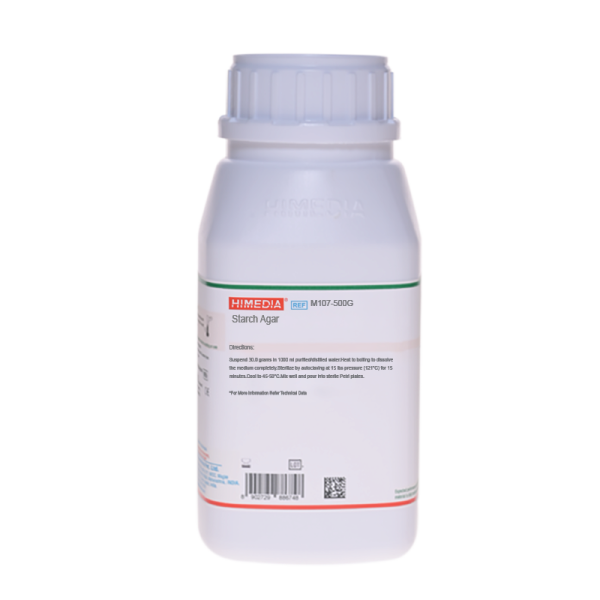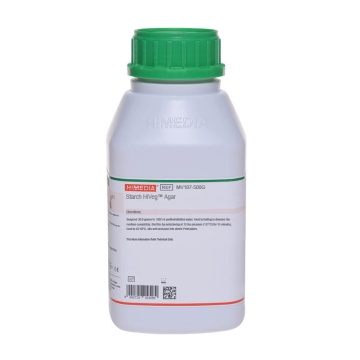 Your enquiry has been submitted
Your enquiry has been submitted
Starch Agar
Intended use
Starch Agar is used for the detection of starch hydrolyzing microorganisms.
Composition**
| Ingredients | Gms / Litre |
|---|---|
| Peptone | 5.000 |
| Sodium chloride | 5.000 |
| Yeast extract | 1.500 |
| HM peptone B# | 1.500 |
| Starch, soluble | 2.000 |
| Agar | 15.000 |
Final pH (at 25°C): 7.4±0.2
**Formula adjusted, standardized to suit performance parameters # - Equivalent to Beef extract
Directions
Suspend 30 grams in 1000 ml purified/ distilled water. Heat to boiling to dissolve the medium completely. Sterilize by autoclaving at 15 lbs pressure (121°C) for 15 minutes. cool to 45-50°C. Mix well and pour into sterile Petri plates.
Principle And Interpretation
Starch Agar was formulated by Vedder (1) in 1915, for the cultivation of Neisseria. Since then, other media have been developed that are superior to Starch Agar for the isolation of Neisseria species, including enriched GC Medium Base. Starch Agar (M107) is recommended for the detection of starch hydrolyzing microorganisms from foods (2) and clinical samples (3). Although the medium was originally formulated to perform the test for the identification of Bacillus cereus, it can be applied to any kind of microorganism where starch hydrolysis activity is required to be analyzed.
Peptone, yeast extract and HM peptone B extract provide nitrogenous compounds, carbon, sulphur, trace elements etc. to the microorganisms. Sodium chloride maintains osmotic equilibrium. Flood the surface of 48 hours old culture on Starch Agar with Grams Iodine (S013). Starch hydrolysis is seen as a colourless zone surrounding the colonies. A blue or purple zone indicates that starch is not hydrolyzed. Size of the clear zone is directly proportional to the starch hydrolyzing activity of the strain under study.
Type of specimen
Isolated Microorganisms
Specimen Collection and Handling:
For food and dairy samples, follow appropriate techniques for sample collection and processing as per guidelines (4,5). For water samples, follow appropriate techniques for sample collection, processing as per guidelines and local standards.(6) After use, contaminated materials must be sterilized by autoclaving before discarding.
Warning and Precautions :
Read the label before opening the container. Wear protective gloves/protective clothing/eye protection/ face protection. Follow good microbiological lab practices while handling specimens and culture. Standard precautions as per established guidelines should be followed while handling specimens. Safety guidelines may be referred in individual safety data sheet and label before opening the container. Wear protective gloves/protective clothing/eye protection/ face protection. Follow good microbiological lab practices while handling specimens and culture. Standard precautions as per established guidelines should be followed while handling guidelines may be referred in individual safety data sheets.
Limitations:
- Due to nutritional variations, some strains may show poor growth.
Performance and Evaluation
Performance of the medium is expected when used as per the direction on the label within the expiry period when stored at recommended temperature.
Quality Control
Appearance Cream to yellow homogeneous free flowing powder
Gelling Firm, comparable with 1.5% Agar gel
Colour and Clarity of Prepared Medium Yellow coloured slightly opalescent gel forms in Petri plates
Reaction Reaction of 3.0% w/v aqueous solution at 25°C. pH : 7.4±0.2
pH 7.20-7.60
Cultural Response
Cultural characteristics observed after an incubation at 35-37°C for 18-48 hours. ($ - on addition of Iodine solution)
| Organism | Inoculum (CFU) | Growth | Starch hydrolysis $ |
|---|---|---|---|
| Bacillus subtilis subsp. spizizenii ATCC 6633 (00003*) | 50-100 | luxuriant | positive reaction,clearing around the colony |
| Escherichia coli ATCC 25922 (00013*) | 50-100 | luxuriant | negative reaction |
| Staphylococcus aureus subsp. aureus ATCC 25923 (00032*) | 50-100 | luxuriant | negative reaction |
| Streptococcus pyogenes ATCC 19615 | 50-100 | luxuriant | negative reaction |
*- Corresponding WDCM numbers
Storage and Shelf Life
Store between 10-30°C in a tightly closed container and the prepared medium at 20-30°C. Use before expiry date on the label. On opening, product should be properly stored dry, after tightly capping the bottle in order to prevent lump formation due to the hygroscopic nature of the product. Improper storage of the product may lead to lump formation. Store in dry ventilated area protected from extremes of temperature and sources of ignition Seal the container tightly after use. Use before expiry date on the label.
Product performance is best if used within stated expiry period.
Disposal
User must ensure safe disposal by autoclaving and/or incineration of used or unusable preparations of this product. Follow established laboratory procedures in disposing of infectious materials and material that comes into contact with sample must be decontaminated and disposed of in accordance with current laboratory techniques (7,8).
Reference
- American Public Health Association, Standard Methods for the Examination of Dairy Products, 1978, 14th Ed., Washington D.C.
- Baird R.B., Eaton A.D., and Rice E.W., (Eds.), 2015, Standard Methods for the Examination of Water and Wastewater, 23rd ed., APHA, Washington, D.C.
- Harrigan W. and McCance M., 1976, Laboratory Methods in Food and Dairy Microbiology, Academic Press Inc. (London) Ltd.
- Isenberg, H.D. Clinical Microbiology Procedures Handbook. 2nd Edition.
- Jorgensen, J.H., Pfaller, M.A., Carroll, K.C., Funke, G., Landry, M.L., Richter, S.S and Warnock., D.W. (2015) Manual of Clinical Microbiology, 11th Edition. Vol. 1.
- Murray P. R., Baron J. H., Pfaller M. A., Jorgensen J. H. and Yolken R. H., (Eds.), 2003, Manual of Clinical Microbiology, 8th Ed., American Society for Microbiology, Washington, D.C.,,
- Salfinger Y., and Tortorello M.L. Fifth (Ed.), 2015, Compendium of Methods for the Microbiological Examination of Foods, 5th Ed., American Public Health Association, Washington, D.C.
- Vedder E. B., 1915, J. Infect. Dis., 16:385.
| Product Name | Starch Agar |
|---|---|
| SKU | M107 |
| Product Type | Regular |
| Physical Form | Powder |
| Origin | Animal |
| Packaging type | HDPE |
| References | 1. Vedder E. B., 1915, J. Infect. Dis., 16:385. 2.Harrigan W. and McCance M., 1976, Laboratory Methods in Food and Dairy Microbiology, Academic Press Inc. (London)Ltd. 3.Murray P. R., Baron J. H., Pfaller M. A., Jorgensen J. H. and Yolken R. H., (Eds.), 2003, Manual of Clinical Microbiology,8th Ed., American Society for Microbiology, Washington, D.C.,, |
| Customized Product Available | No |








